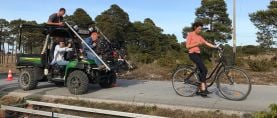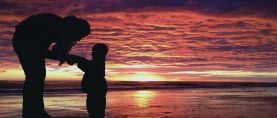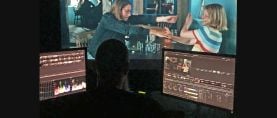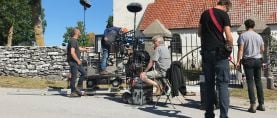
Filming With Firearms
Firearms experts and cinematographers form relationships that go beyond mutual respect. We share many characteristics. We want it good, we want it safe, we want it quick, and we want it within budget.
By Dave Brown
It’s been said that if you find a job you love, you’ll never work a day in your life. Well, in a career that has so far spanned 25 years of handling firearms on film sets, collaborating with actors to make their characters look real, and helping to keep casts and crews safe, I don’t think I’ve actually “worked” a day in my life. And I’ve loved every minute of it.
Even more importantly, I’ve managed to learn a few things about safety and the use of firearms in the film industry.
Filmmaking is a collaborative process. I learned right from day one that every job on a film set is important. Coordinating the safety of firearms is perhaps one of the more unique occupations in the industry, but the role is still just one small cog in a very large wheel. All of those “cogs” need to work together to get the shot quickly, safely and within budget.
This is why there is a close relationship between directors, cinematographers, camera operators and experts such as myself who are there to help get those shots. A good firearms expert is not just there to supply guns; we also help tell the story. To do that, we use everything from fake firearms, designed to look acceptable from a distance, to real firearms that both look authentic and can fire blanks when desired.
“Experienced firearms experts directly contribute to the story while helping you achieve the shots you want, safely and quickly.”
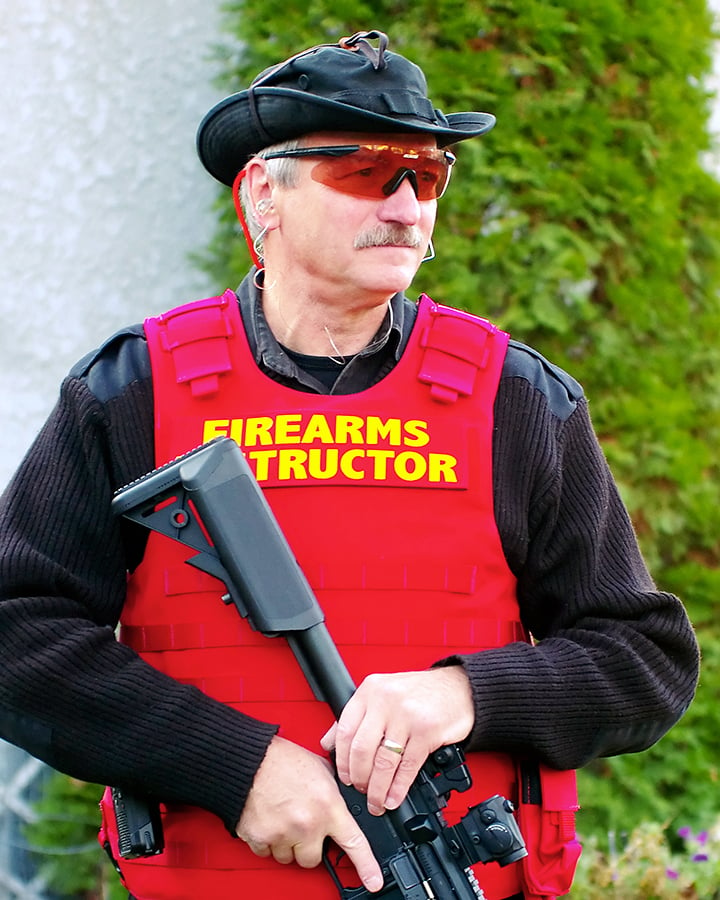
CGI may be used for close-range gunshots that could not be safely achieved otherwise, but yes, even with all the advancements in visual effects and computer-generated imagery, we still fire guns with blanks. The reason is simple: We want the scene to look as real as possible. We want the story and characters to be believable. Blanks help contribute to the authenticity of a scene in ways that cannot be achieved in any other manner. If the cinematographer is there to paint a story with light and framing, firearms experts are there to enhance a story with drama and excitement.
But this expertise costs money. Working firearms are not cheap, and neither are blanks. So why spend the money when you can just give everyone a plastic gun and say, “Go ahead, act — we’ll fix it in post”? Because it’s not just the look of the guns. Experienced firearms experts directly contribute to the story while helping you achieve the shots you want, safely and quickly.
Experience Matters
When handled by people who know what they’re doing, firearms are as safe as any other prop on set. Their presence should not put people on edge. They are one of the tools of filmmaking, and extra time spent in preparing for and setting up scenes involving firearms and blanks will pay off in the authenticity of the scene, while saving time and money by getting the shot in the camera instead of fixing it in post.
Cast and crew need to be calm while they go about their jobs, not worrying about their safety because someone constantly reminds them how dangerous firearms are, or runs around yelling “Fire in the hole!” when guns are loaded with blanks. Safety is not about scaring people. It’s about treating firearms with respect, consistently checking every firearm on set, and working with the same quiet, calm professionalism as a good camera operator.
The mark of a good firearms safety coordinator is knowing our jobs so thoroughly that we can almost always find a way to get you the desired shot. This is why an “expert” cannot just be someone with a license or certificate hanging on their wall. A firearms license does not make anyone an on-set expert any more than a driver’s license makes someone a stunt coordinator.
Firearms experts know guns as much as cinematographers know lenses. We know safe distances and angles. We know safety gear. We know how to safely get gunshots with blanks at almost any distance you desire. But good firearms experts know the importance not just of working with guns, but also of getting along with people. We are not on set to instill fear. We’re there to inspire confidence. We may know when we need to say “no” but, just as importantly, we know how and when to say “yes.”
The need for expertise is not restricted to real firearms; there are risks even with fake firearms. We all know the costs of using amateurs or doubling up crew positions, but other less-obvious cost-cutting measures, such as using all replicas and generating all the muzzle flashes in post, can also hurt performances — actors will hate it. Unless you spend time preparing for CGI scenes and use experts who know what they are doing, the lack of heft and noise can make the scene seem fake, and bad techniques can make the cast look like amateurs.
When there are firearms on set, you should be able to glance around and find an experienced firearms safety expert standing near the camera to give guidance to the cast and crew. We also sometimes stand directly in the line of fire, to provide a safe eye line for the actors. We stand in front of our work, and I would never ask an actor or crewmember to stand anywhere I am not willing to stand myself.
There is a saying that amateurs practice until they get it right; professionals practice until they can’t get it wrong. Handling the firearms on a film set should be as important to the cast and crew as the packing of a parachute is to a skydiver. After all, skydivers don’t get their parachutes packed by the amateur who finally got it right after 10 tries; they get them packed by the professional who has never gotten it wrong in 30 years.
It’s like hiring a cinematographer. Productions not willing to pay for a professional will be shocked at the cost of employing an amateur.
“I never forget that if an actor makes a mistake, they get another take, but if a weapons handler makes a mistake, it will make headlines in the morning.”
Working With Blanks
A blank is a cartridge that’s fired from a real or blank-firing firearm. The blank contains no bullet — the actual projectile part of a cartridge — but is loaded with enough gunpowder to create a bright flash at the end of the barrel, thereby convincing the audience that the gun has been fired. Ironically, the flash at the end of the barrel is pure Hollywood. Real firearms rarely have any muzzle flash. The gunpowder in a real cartridge is designed to burn within the length of the barrel. In order to burn in front of the muzzle and create that bright flash, blanks need far more gunpowder than the actual cartridges they are designed to simulate.
Even without a projectile, the burning flame, hot gases, and debris from burned and unburned flakes of gunpowder create a very real hazard at close distances. However, these hazards are based on physics and can therefore be predicted and controlled by someone who knows what they’re doing.
The muzzle flash from a blank is very brief. Although our eyes can usually see it clearly, that flash only lasts a fraction of a second. Gunshots from modern rifles and handguns are not likely to be captured on any more than one or two frames. Even then, there is no guarantee that you’ll capture a “good” flash. This is where experience is invaluable. Skilled cinematographers and camera operators know that a flash might only be captured in one out of four or five attempts. How do we resolve this? You can sometimes optimize capture with variable shutter angles and frame rates, but when we need one nice, clean muzzle flash, the solution is often as simple as shooting another take.
You can actually tell when you’ve captured a good flash. If you are shooting on film and you see a good flash in the monitor or eyepiece, trust me: It was not captured on the film frame. Shoot another take. If you’re shooting digital, the opposite is true — if you like what you saw in the monitor, it is there. Digital also gives you the advantage of playback, so you can immediately check to make sure you got a good flash.
If the muzzle flash ended up invisible, truncated or maybe just a puff of smoke, shoot another take. Every time I hear someone yell, “We’ll fix it in post!” I die a little bit inside. As a perfectionist, I want to fix it now — and it’s often as simple as reviewing the footage and shooting another take. Guns are not special effects; our resets are quick.
Some firearms are “better” than others. Much like the flashbulbs on an old Graflex Speed Graphic press camera, shotguns and muzzle-loading period firearms have longer burn times, and flashes are often captured across multiple frames.
Brown’s Law
Blanks expel gunpowder and hot gases out of the front of the barrel in a cone shape. This is harmless at longer ranges, but the explosion can seriously injure someone if it’s too close. Early in my career, I wanted to find a simple way to explain these hazards and readjust the setup as required.
Brown’s Law was born.
Brown’s Law simply states that the hazard of a scene involving a blank is directly proportional to the power of the blank, and inversely proportional to the square of the distance away from the gunshot. As a formula, it looks like H = P/D2, where H is the hazard of the scene, P is the power of the blank, and D is the distance from the muzzle of the gun to the actor or crew standing in front of it.
The formula offers a good illustration of why some scenes are more easily shot than initially expected, while other “simple” scenes can cause nightmares. The single most important factor in the safety of your cast when firing a blank is sufficient distance. Distance is your friend. We can protect your crew with safety gear; we can’t always put safety gear on actors.
We can sometimes employ blanks with varying amounts of gunpowder, giving us different power levels and adding further control over the hazards, but that is not always possible. If we substitute a half-power blank for a full-power blank, we cut the hazard to anyone standing in front of that gunshot by half. But semiautomatic and automatic firearms require a certain power to cycle the action properly, and using an underpowered blank can result in serious — and very dangerous — jams.
This is why we use distances and angles to keep actors safe, and we always plan for the most powerful blank available to us. Blanks should always be aimed slightly to the side of another actor, but no matter how much we cheat the angle, the blast still exits the barrel in a cone shape — and actors may miss their marks entirely. In practical terms, this is why the vast majority of gunshots in motion pictures are done as a tight shot on the actor firing the gun. There is usually no reason why we need the actor who’s being “shot” to be in the same frame at the same time.
But don’t forget, safety does not end with the cast. Even though the actor getting “shot” might be relaxing in their trailer, your camera crew will still be in front of the gunshot. Protecting the crew and the camera is every bit as important a part of the job. Brown’s Law still applies.
Safe distances vary widely depending on the load and the type of firearm, which is why we test everything in advance. But I’ll share a secret: Normally, I take the distance that people need to be away from a gunshot, and then triple it. That way, we avoid dangers that can result if our safe distances are gradually inched closer, or when a full-power blank has to be quickly substituted for a half-power or quarter-power blank to achieve a better look. Tripling the distance also provides that one extra redundancy that allows for the “human factor” in the event that an actor makes a mistake.
At moderate ranges — with a handgun, that might be 10' to 15' — both actors and camera operators will feel the pressure wave from a blank, but the two most important things we worry about are eye protection from the debris and ear protection from the noise at virtually any distance in front of the gun, even well off to the side.
Modern wraparound safety glasses and face shields do an excellent job. They are made from a material called polycarbonate, which provides good protection from debris or impact, and in my extensive tests, I know that if everything goes wrong, that thin shield of polycarbonate will protect against blast debris, metal shavings or the force of the explosion from even full-load blanks at contact distance. Wear your safety gear and make sure your crew does, too.
Actors don’t always wear earplugs; in wide, outdoor spaces, it’s more a matter of choice and personal comfort level. The sound of a blank may seem loud, but it does not contain the same damaging frequencies as the sound of a real bullet when it breaks the sound barrier just in front of the muzzle. But hearing damage is cumulative. In tight spaces or at close range, everyone should be wearing earplugs. Plus, the sound is significantly higher in front of the muzzle than it is behind, so camera crews should also be wearing both face protection and good-quality earmuffs (also called “cans”).
At particularly close range, earmuffs over the top of earplugs can even help to prevent that flinch that might jerk the camera or bump the focus every time the gun goes off. I often bring several sets of modern electronic earmuffs for the camera crew because they can amplify ambient sounds while cutting out the sudden sound of a gunshot. The best electronic muffs work by cutting out only the frequencies of a gunshot; the wearer can still hear normal sounds.
No one should be injured for the sake of a movie. Remind the crew that no one looks like a hero because they forego eye or ear protection. Eyes can never be replaced, and long-term hearing damage can never be undone.
Collaborating With Talent
The best part of a career in film is the opportunity to work with so many amazingly talented actors and cinematographers. One of the highlights was teaming with cinematographer James Glennon, ASC and actor Robin Williams on the 2005 film The Big White. During shooting, I was fortunate to become friends with both — and I quickly found out that beneath the humor, Robin Williams never missed a detail.
Many of our scenes involved a revolver. Every day I would show him the empty firearm, load six dummy cartridges into the chambers so it looked fully loaded to camera, and demonstrate that it was completely safe by pointing it in a safe direction and pulling the trigger eight times.
Over the course of two months, he silently observed that I always pulled the trigger exactly eight clicks — two more than necessary for the revolver’s six chambers. Then, on our final day, as I was preparing for our last scene together, Robin asked me why I always pulled the trigger eight times. I told him my personal reason: “The first six are for you, the seventh one is for me, and the eighth one is for Brandon Lee.” The very talented James Glennon, also a skilled person with a firearm, nodded his head in silent agreement.
In the film business, lessons are sometimes learned the hard way. But the most important lesson I ever learned was from my very first day on the job: I don’t work with guns. I work with people
I’m fortunate to be able to collaborate with so many talented people doing such amazing work. I never forget that I’m working with friends and colleagues whom I need to keep safe. I never forget that if an actor makes a mistake, they get another take, but if a weapons handler makes a mistake, it will make headlines in the morning.
Firearms experts and cinematographers form relationships that go beyond mutual respect. We share many characteristics. We want it good, we want it safe, we want it quick, and we want it within budget. We speak the same language. We are some of the most experienced people on set. We understand each other. And we make no apologies for being perfectionists, because at the end of the day, we both intensely love what we do.
Based in Winnipeg, Canada, Dave Brown is a professional firearms instructor who has worked with military, police and government agencies on advanced skills and weapons handling. As a firearms safety coordinator, he has worked on features including Stryker, The Big White, Capote, The Plague, The Lookout, You Kill Me, Hunting Season, Reasonable Doubt, Heaven Is for Real and A Dog’s Purpose, as well as television series and theater productions. Brown also helped develop a firearms safety presentation for IATSE film and theater technicians across North America.

